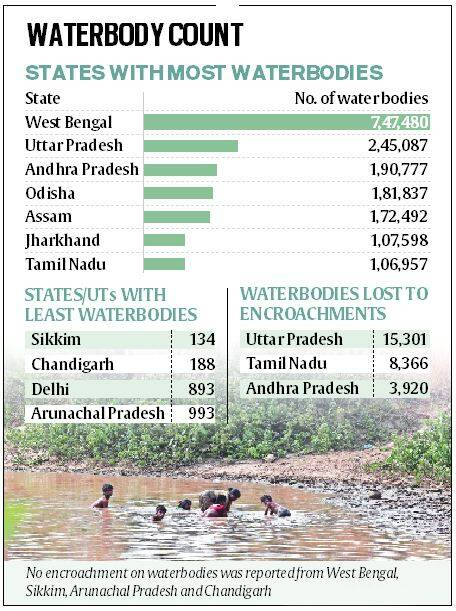Important Facts For Prelims
First Waterbodies Census
- 22 Apr 2023
- 3 min read
Why in News?
The Ministry of Jal Shakti recently released the report of its first-ever census of water bodies, revealing crucial insights into the country's water resources.
- The census provides an extensive inventory of water sources in India, highlighting disparities between rural and urban areas and varying levels of encroachment.
What is the Census of Waterbodies?
- About:
- The census of waterbodies was conducted in conjunction with the 6th Minor Irrigation Census for 2017-18.
- It defines a waterbody as "all-natural or man-made units bounded on all sides with some or no masonry work used for storing water for irrigation or other purposes."
- The census aimed to provide an inventory of India's water resources, including natural and man-made water bodies like ponds, tanks, lakes, and more, and to collect data on the encroachment of water bodies.
- Key Insights from the Census:
- The census enumerated a total of 24,24,540 water bodies across the country, with West Bengal accounting for the most (7.47 lakh) and Sikkim the least (134).
- The report reveals that:
- West Bengal has the highest number of ponds and reservoirs
- The top district in terms of waterbodies is South 24 Parganas in West Bengal.
- Andhra Pradesh has the highest number of tanks
- Tamil Nadu has the highest number of lakes
- Maharashtra leads in water conservation schemes
- West Bengal has the highest number of ponds and reservoirs
- The report highlights that 97.1% of the waterbodies are in rural areas, with only 2.9% in urban areas.
- Most of the waterbodies are ponds, followed by tanks, reservoirs, water conservation schemes, percolation tanks, check dams, lakes, and others.
- Encroachment of Waterbodies:
- The census also collected data on the encroachment of waterbodies for the first time, revealing that 1.6% of all enumerated waterbodies are encroached, with 95.4% of encroachments in rural areas and the remaining 4.6% in urban areas.
- A significant percentage of encroachments cover more than 75% of the waterbody's area.
- The census also collected data on the encroachment of waterbodies for the first time, revealing that 1.6% of all enumerated waterbodies are encroached, with 95.4% of encroachments in rural areas and the remaining 4.6% in urban areas.
- Significance:
- The census provides crucial data for policymakers to make informed decisions regarding water resource management and conservation.
- It highlights disparities between rural and urban areas and the need for effective measures to prevent encroachment.
- The data collected in the census can serve as a baseline for future assessments of India's water resources, helping to monitor changes and progress toward sustainable water management.







